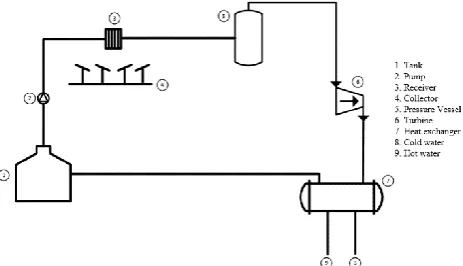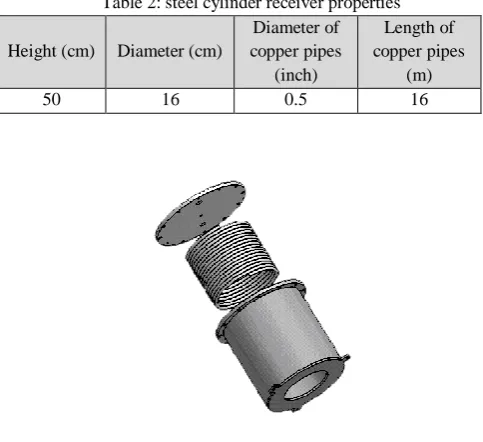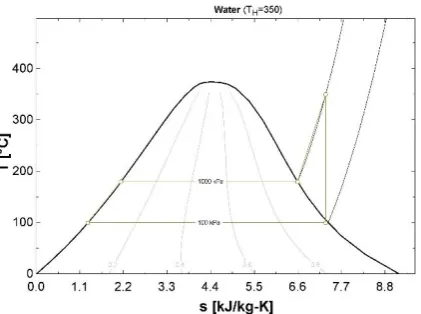Author name / JHMTR 00 (2013) 000–000 20
1. Introduction
Today’s the world’s climate is getting worse and worse. The evidences which show this problem are temperature increasing of the air and ocean, widespread melting of snow and ice and rising global average sea level. The release of greenhouse gas carbon dioxide into atmosphere by burning fossil fuels is the most known cause of climate change [1]. However, using renewable energy like solar energy can provide clean energy which has much less dangerous effects on the environment. It is regarded that solar energy has the most potential all over the world.
Concentrating Solar Power (CSP) system refers to systems, which concentrate the solar radiation in order to produce hot air or steam to be used in conventional power cycles such as Rankine cycle or Bryton cycle to generate electricity. The power generated by these systems can be in the range of few kW to several 100 MW [2,3]. Actually, CSP systems can be divided into 2 groups: Line focusing type and point
trough systems which have curved mirrors that concentrate solar radiation on to a receiver which placed on the focal line of the mirrors. The concentration ratio of this is between 30 to 100 [4-6]. The receiver is one of the key component of these systems and in parabolic through systems is a steel pipe usually placed in an evacuated glass in order to reduce heat loses due to conduction and convection. Due to the limitation of direct evaporation of water, some specific oil is used in the receiver in order to absorb the solar energy. So because of the limitation of the oil the maximum operating temperature of these systems is limited by 400oC. Dish systems and central receiver systems
belong to the second group which is point focusing type. In these systems solar radiation is concentrated on the focal point of the system, which causes higher operating temperature in comparison with line focusing systems. So, due to Carnot equation of efficiency it causes higher efficiency of these systems rather than line focusing types. Dish systems have parabolic dish shaped reflectors which
Click here, type the title of your paper, Capitalize first letter of each words
First Author
a, Second Author
b,*aFirst affiliation, Address, City and Postcode, Country
bSecond affiliation, Address, City and Postcode, Country
Journal of Solar Energy Research 21 (2017) 20-24
Journal of Solar Energy Research (JSER)
Journal homepage: jser.ir
A B S T R A C T
Click here and insert your abstract text. Click here and insert your abstract text. Click here and insert your abstract text. Click here and insert your abstract text. Click here and insert your abstract text. Click here and insert your abstract text. Click here and insert your abstract text. Click here and insert your abstract text. Click here and insert your abstract text. Click here and insert your abstract text. Click here and insert your abstract text. Click here and insert your abstract text. Click here and insert your abstract text. Click here and insert your abstract text. Click here and insert your abstract text. Click here and insert your abstract text. Click here and insert your abstract text. Click here and insert your abstract text. Click here and insert your abstract text. Click here and insert your abstract text. Click here and insert your abstract text Click here and insert your abstract text Click here and insert your abstract text Click here and insert your abstract text Click here and insert your abstract text Click here and insert your abstract text Click here and insert your abst
© 2013Published by University of Tehran Press. All rights reserved.
ARTICLE INFO Received:
Received in revised form: Accepted:
Available online:
Keywords:
Type 3-6 keywords here,
separated by semicolons ;
A Novel Design of a Low cost CSP Using Turbocharger as an Expander
Shokouhmand
a,H., Ebadi
a,*,S., Pournadali Khamseh
a,A., Negahban
a,M., Sattari
a,A.,
Hosseini-Doost
a,S.A.
aUniversity of Tehran, Department of Mechanical engineering, Tehran, Iran. *E-Mail: soroush_ebadi@ut.ac.ir
Journal of Solar Energy Research (JSER)
Journal homepage: www.jser.ut.ac.ir
A B S T R A C T
The aim of this paper is to introduce a design and build of a small low cost CSP system with simplicity in construction as a means of power generator for remote areas and residential buildings. Advantages of the designed device are: There are no curvatures, instead of that some flat mirrors are installed in a rectangular Aluminum frame. In order to reach higher efficiency, a cavity receiver and a two axial sun detector system is used. Also a modified turbocharger is playing role as an expander. By making required number of the collector panels parallel (or series) the requested output power or mass flow rate can be achieved. The results show that the maximum temperature of empty cavity receiver (without working fluid) is around 710 degrees Centigrade. Hence, the effectiveness of the receiver is about 92% by calculations. For 6.2 m2 collector panel, output is 1
KW and the cost is estimated to be roughly around $1350. Also there is another output which provides hot water for heating purposes.
© 2017 Published by University of Tehran Press. All rights reserved.
ARTICLE INFO
Received: 30 September 2016
Received in revised form: 25 December 2016 Accepted: 30 December 2016
Keywords:
concentrate the solar radiation on to a receiver that is placed in the focal point of the reflector. These systems can generate power in conventional or Organic Rankine Cycle (ORC), open and closed Bryton cycle and Stirling engine. The concentrating ratio of these systems is more than 2000 times [7] and the maximum operating temperature is around 750oC [8].
The main problem of these systems is their initial cost and efficiency. In designed device of this work a new mechanism for mirrors is introduced. In Order to increase the efficiency a cavity receiver is used and also for decreasing the cost a modified turbocharger is playing role as an expander.
2. Design Modules
The CSP system consists of many parts. It includes a frame which holds the heliostat shaped mirrors, receiver which absorb the concentrated solar radiation, a 2-axis tracking system in order to exactly locate the sun position and concentrate the solar radiation, heat pipe in the receiver for absorbing the solar radiation and converting it to heat energy, a pump to circulate the working fluid and raising its pressure, an expander to generate power, a generator in order to convert mechanical power to electrical power and a condenser to condense the exiting vapor of turbine.
Firstly, it is of concern to design a system of mirrors which can turn to sun and concentrate its radiation. As it will be discussed later, a frame that consists of many small flat mirrors and can be rotated towards sun is chosen to concentrate the solar radiation at the focal point of the system. Then, the design of receiver must be taken into account. It is very important to design a receiver witch can absorb the most of concentrated radiation with small loses. After that, the 2-axis tracking system will be designed. As the system is a kind of point focusing type, the exactitude of the tracking system must be very high and should locate the sun exactly. Otherwise, solar radiation will not focus on the focal point or where the receiver is placed. Then, an expander must be designed which fits the condition of the entering and exiting working fluid properly and operating with maximum efficiency. A pump and condenser witch are inseparable parts of a Rankine cycle should be chosen and finally, a suitable generator must be chosen for this system. Figure 1 shows a schematic view of the designed system.
Figure 1: Schematic view of the designed system
3. Strategies and Methods
Rectangular frame and flat mirrors
In order to decrease the cost of system, no curvatures are used. Indeed, instead of using curvature frame, a simple mechanism is designed which mirrors are installed on it. Then according to sun radiation angular, all of the mirrors are set to reflect to a specific point. By this way, the cost of using curvature mirrors and frames are eliminated. Also, there is nolimit for the system’s design dimension.
In this project 306, 10cm×10cm flat mirrors are installed in a 2m×2m rectangular aluminum frame. Then, the frame should be faced to the sun with angle of 90 degrees. In the next step, each of the mirrors should be adjusted in order to reflect to aspecific point.
Expander
One of the main problems for using generated steam was choosing a proper expander.
The best choice was using a micro turbine, although, it is high cost and it is contrary to the aim of the work.
Table 1: Side by side comparison of expander strategies Scroll
compressor Turbocharger
Curtis Turbine Efficiency Low High Higher than
Turbocharger Cost Low High Higher than
Turbocharger
In order to choose a low cost expander with a suitable efficiency a Turbocharger selected for this work.
Cavity receiver
In small scale CSPs the efficiency of collector is an important issue. In order to absorb most of the solar radiations, a steel cylinder cavity receiver was designed and inside of it, spiral copper pipes are located which the working fluid runs through them.
The steel cylinder receiver properties and its modeling are shown in Table 2 and Fig. 2 respectively:
Table 2: steel cylinder receiver properties
Height (cm) Diameter (cm)
Diameter of copper pipes
(inch)
Length of copper pipes
(m)
50 16 0.5 16
Figure 2: designed cavity receiver
Working Fluid
For working fluid two cases could be selected in this device: Water or an organic fluid.
Water has higher evaporation temperature than organic fluids. As a result, it has more enthalpy so the efficiency will be higher. Also by using water as a working fluid, condensing temperature for this cycle will be 99.61c o which
can be used for heating cold water at the end of cycle. Hence, water is being used in this work.
Generator
In order to generate electricity, an asynchronous generator is used. This generator will couple to turbocharger. The generated electricity will be stored in a battery for night usage or will be used directly.
Sun detector system
In solar systems, especially solar thermal ones the angle of Sun’s radiation is very important. In order to receive the highest rate of radiation, the best angle is 90 degrees. Thus, a sun two axis detector system is needed.
To reach this goal, an electronic LDR Module is used. When it faces the sun with different angles, the output is different voltages. It is obviously apparent that the highest voltage means the highest radiation of the Sun. In another word, the highest voltage shows that the sun radiation angle is 90 degrees.
In the next step, according to received voltage a driver is programmed which controls the step motors. Then, the aluminum frame turns around to find the sun.
4. Results and discussions
Firstly 119 of total 306 flat mirrors were used to see what temperature rise of the cavity receiver will be achieved. Note that, in this test the cavity receiver was empty of heat transfer fluid and the temperature rise only observed in the body of the receiver. The maximum temperature achieved in this test was 305 centigrade degrees in 45 second, which according to ambient temperature (30oC) the temperature
rise was 275oC. After that, all of the 306 flat mirrors were
arranged in their positions in the aluminum frame. This time the cavity receiver reached the maximum temperature of 710oC. By this information the amount of radiation absorbed
by the receiver and its effectiveness can be achieved by the following procedures and some simple equations of heat transfer. When the body of empty receiver reaches the maximum temperature, due to the law of energy conversion the heat transfers due to the convection from the receiver to surrounding is equal to the radiation absorbed by the receiver. So:
(1)
(2) Convective heat transfer coefficient is considered 16.7
. Also, outside area of the receiver is computed by the following equation:
In the above formula, D is the outside diameter of the receiver and L is the length of the receiver. The designed and produced receiver has a diameter of 16 cm and length of 46 cm. So the outside area of the receiver will be:
(4)
Maximum temperature rise is as the following:
(5)
Solar radiation heat flux in the condition of test (Q”) is considered 1000 . The area of each mirror (A’) is 0.01 m2, and number of mirrors is 306.
The effectiveness of cavity receiver is computed as the following:
(6)
The effectiveness of the designed receiver according to the above information and specifications is calculated and is 93.26 %, which means 93,26 percent of the solar radiation of the sun is absorbed in the cavity receiver and it is due to the structure of the cavity receiver and point focusing type of collectors.
Figure 3: T-S diagram of water as the working fluid of the research
Based on the calculations, the effectiveness of whole system will be 18.37%. Furthermore, for 3.06 m2 area of mirrors
power of turbine is 515W. Temperature of Condenser is 99.61oC and mass flow rate is 0.001kg /s.
5. Conclusions
Taking into account all of the mentioned factor we can reach a conclusion that according to today’s warning on Global-Warming using of renewable energies should be considered. Solar systems such as PVs and thermal ones have the
In this paper a low cost CSP was introduced. This system provides customers with some advantages including: easy assembling and transporting because all parts of it can be divided and can be assembled like a puzzle. Also, lower cost in comparison with other similar systems. No curvature frames or mirrors are needed, hence, there is no limitation on its dimensional design, just the limit is in total weight. By designing and installing a cavity receiver the efficiency is increased. This system is ideal for using in any place from cities to remote areas. This system has the potential that number of these systems can be attached together and work simultaneously. As an illustration, 10 frames of mirrors can be attached together in a parallel form. So that, the total mass flow rate of the turbine is increased and the more power can be generated.
References
[1] Solomon S., Qin D., Manning M., Chen Z., Marquis M., Averyt K.B., Tignor M. and Miller H.L. (eds.), 2007: Climate Change 2007: The Physical Science Basis, Cambridge University Press, New York, USA
[2] Müller-Steinhagen H., Trieb Freng, Trieb Franz, 2004: Concentrating solar power – A review of the technolgy, in: ingenia, Royal Acadamey of Engineering, issue 18, pp. 43-50.
[3] Fernández-García A., Zarza E., Valenzuela L., Pérez M., 2010: Parabolic-trough solar collectors and their applications, Renewable and Sustainable Energy Reviews 14 (7), pp. 1695-1721.
[4] Bennett S., 2007: The Encyclopedia of Energy, Global Media, Delhi, India.
[5] SolarPACES, 2011: Technology Characterization Solar
Parabolic Trough, available at:
http://www.solarpaces.org/CSP_Technology/docs/solar_trou gh.pdf, as accessed 31.08.2011.
[6] Geyer M., Lüpfert E., Osuna R., Esteban A., Schiel W., Schweitzer A., Zarza E., Nava P., Langenkamp J., Mandelberg E., 2002: EUROTROUGH - Parabolic Trough Collector Developed for Cost Efficient Solar Power Generation, 11th Int. Symposium on Concentrating Solar Power and Chemical Energy Technologies, 4-6 September 2002, Zurich, Switzerland.
[7] SolarPACES, 2011a: Technology Characterization Solar
Dish Systems, available at:
[8] Richter C., Teske S., Nebrera, J., 2009: Concentrating solar power global outlook 09– why renewable energy is hot, Greenpeace International, SolarPACES and ESTELA.
[9] Pitz-Paal R., 2011: High temperature solar concentrators, Encyclopedia of life support systems (EOLSS), available at: www.eolss.net/ebooks/Sample%20Chapters/C08/E6-106-06-00.pdf, as accessed 02.09.2011.
[10] European Commission (EC), 2002: SOLGATE Solar hybrid gas turbine electric power system – final publishable report, Publication office, European commission contract ENK5-CT-2000-00333.


